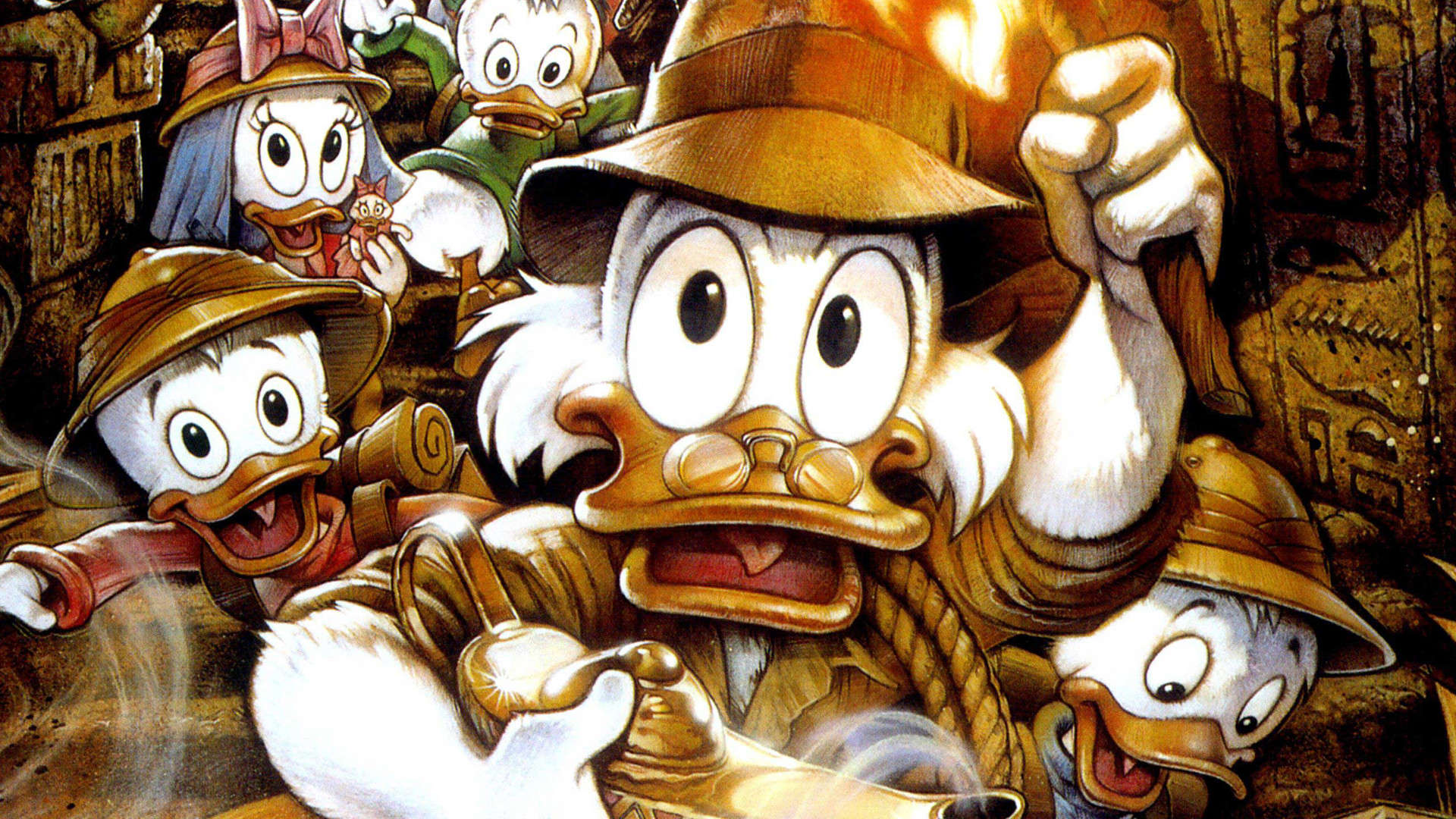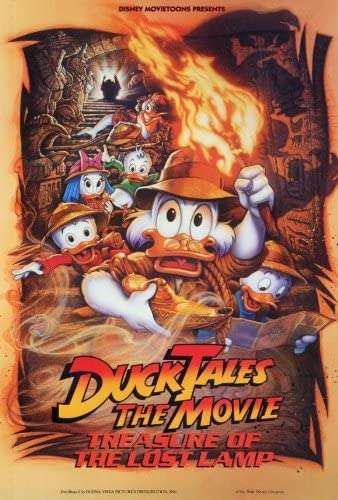Create a free profile to get unlimited access to exclusive videos, sweepstakes, and more!
DuckTales the Movie: Treasure of the Lost Lamp was a true Disney experiment

Three decades ago today, DuckTales the Movie: Treasure of the Lost Lamp began its abrupt and uneventful release in theaters, quickly becoming an afterthought among the larger Disney animated features of the early 1990s. And yet, while its box office receipts and standing in history would say otherwise, Treasure of the Lost Lamp exists as a significant film in the grand story of the world’s most famous animation studio.
Based on the extremely popular and iconic DuckTales animated series (taking place between the shows third and fourth seasons), the film follows Scrooge, Launchpad, the billionaire's adventurous nephews Huey, Dewey, and Louie; and Webbigail Vanderquack, as they travel to Egypt to search for the lost treasure of Collie Baba. A treasure map found among the legendary thief’s belongings takes them to a hidden pyramid, where the gang not only find Baba’s treasure, but also an old lamp that contains a genie inside.
Merlock the Magician, an evil wolf who can change his form to any animal he chooses thanks to a powerful amulet, wants that lamp, too. The lamp, together with his amulet, would give Merlock limitless power, so Scrooge and Co. must try to stop him from merging the two magical objects so they can protect their new friend the genie (who the kids refer to as “Gene”) from the evil sorcerer — and to keep Merlock’s hands away from Scrooge’s beloved money.
Treasure of the Lost Lamp was the first feature film produced by Walt Disney Television Animation, going under the newly established “MovieToons” banner, and the first Disney animated feature not to be animated at the Walt Disney Animation Studios in Burbank, California. Instead, it was outsourced to a number of different studios in Europe, Asia, and Oceania. “Disney wanted to experiment,” David Weimers, who created DuckTales and along with his partner Ken Koonce, wrote most of the early episodes of the series, told SYFY WIRE. “They wanted to see if we could do sort of ‘Disney-lite;’ a feature film, but for less money; they also wanted to see if they [foreign animators] could succeed, so we set up special studios in London, France, and Australia.”
The French studio, where most of the background, layouts, and animation was done, took up two floors in an office building in Montreuil, a suburb of Paris, and was supervised by the Brizzi Brothers, French animators and directors who sold their studio to Disney in 1989. Pierre Lyphoudt, who got his start working in animation with Treasure of the Lost Lamp, starting as an inbetweener before being promoted to assistant animator (and who grew up collecting the Carl Barks comics the series was based on) echoed Wiemers sentiment. “It was a test for the French people,” he said to SYFY WIRE over Zoom. “They wanted to see if French animators would be able to do this kind of movie.” Nevertheless, the excitement of working on a Disney feature was palpable. "It was very big for us, Disney coming here to Paris, it was incredible," Lyphoudt said. “There was no Pixar or DreamWorks, Disney was really the only one doing feature films.”
Even though Treasure of the Lost Lamp was separate both figuratively and literally from the studio at Burbank, the main studio did have some involvement in the production of the film. Larry Ruppell — the only American on staff — working as an assistant animator on the film, told SYFY WIRE that the main Disney studio, “designed the characters and did the storyboards,” afterwards, the Paris studio was handed the drawings, along with the film’s soundtrack, and once the animation was completed and approved, the storyboards were sent to China where they were painted onto cels, the film being the last Disney feature to use cel-animation as Disney moved to digitally painting and inking drawings starting with The Rescuers Down Under.
In the weeks leading up to its release, Disney promoted the film with an Indiana Jones-styled poster — designed by Temple of Doom and Last Crusade poster designer Drew Struzan — thanks to Disney Television Animation president Gary Kriesel’s obsessive fascination with Steven Spielberg’s iconic series. “He always wanted everything to be Raiders of the Lost Ark,” Weimers recalled, “and I said to him, ‘These are ducks we're dealing with, it just can't be Raiders.’” In the end, Kriesel got his wish, not only in the poster but in the film's title card, “I lost that battle,” Weimer said, “and you can tell I'm still bitter about it.”
Weimers also served as voice director on the film, and while setting up auditions to fill the roles of the newer characters, had only one person in mind to voice the genie: “I wanted Robin Williams.” Weimers and Williams both entered the industry around the same time and worked together previously on Mork & Mindy. To bring Williams' voice to animation, Weimers called Jeffrey Katzenberg, currently the founder of Quibi, the co-founder and former CEO of DreamWorks Animation, and at the time the chairman of Walt Disney Studios.
“I called Jeffrey said, ‘I want Robin Williams to be the voice of the genie.’” Weimers recalled. “He said, ‘I think that is a terrific idea! I'll start working with Robins managers and I'll get back to you.’” A few days passed without word, so Weimers called Katzenberg for an update, the chief informing Weimers that he was in talks with Williams' team. A few days after that, with still no word on whether Williams would be heading to Duckberg, Weimers again called Katzenberg, “and suddenly,” Weimers said, “Jeffrey isn't taking my calls.”
Williams, of course, would go on to voice a genie, sending his voice talents not to Duckberg but to Agrabah, becoming one of the most iconic characters in Disney history. Weimers ended up with Rip Taylor, the famous confetti-tossing actor and comedian. “He was just a wonderful guy, terrific to work with, but I just didn't get that caliber of performance that they ended up getting with Robin.” Thirty years later, Weimers — who has been spending much of his retirement on cruises, giving lectures, and telling stories about his years in Hollywood — says that his “sad DuckTales story,” is a personal favorite. “People love hearing the Robin Williams story.”
The film opened seventh at the box office on its opening weekend, grossing just $3.8 million, almost half what The Little Mermaid did nine months prior. Overall, it wound up grossing $18 million off a reported $20 million budget, a little under $2 million less than Hannah-Barbera’s Jetsons: The Movie.
A planned sequel was scrapped — the “MovieToons” logo never to be seen again on a Disney production — however, while underperforming at the box office, the experiment was deemed a success. “[Disney was] very impressed by what the studio in Paris was doing, so they gave them more opportunities to work on feature films,” Ruppel said. The mindset of the Paris studio, according to Lyphoudt was, “we succeeded, but we knew we had to improve.” The French studio would work on TV series such as TaleSpin, Goof Troop, and Bonkers! before their next feature, the more successful and beloved A Goofy Movie. The studio would continue to work on both film and television productions until being shut down in 2003.
“Movietoons” would fully incorporate into Disney Animation Studios by 2003, the name changed to “Disneytoons” in 2004, and they would go on to produce mainly straight-to-video releases with the rare theatrical release, the final one being 2015’s Tinker Bell and the Legend of the NeverBeast.
Three decades later, Treasure of the Lost Lamp has been mostly forgotten, perhaps because for years its only DVD release was exclusively for Disney Mouse Club members, not getting a full retail release until 2015 (it’s currently available to stream on Disney+). It will not be anyone’s first, second, or even fifth choice when discussing major Disney pictures of the 1990s, however, it is still a significant part of Disney history. It was the last feature from the most famous animation studio in the world to use the traditional cel-animation technique, an experiment from a company that has become (let’s face it) more risk-adjacent, and it opened the gates for a number of artists and animators, granting their wish to work on a Disney animated feature, without the help of a magical genie.



























